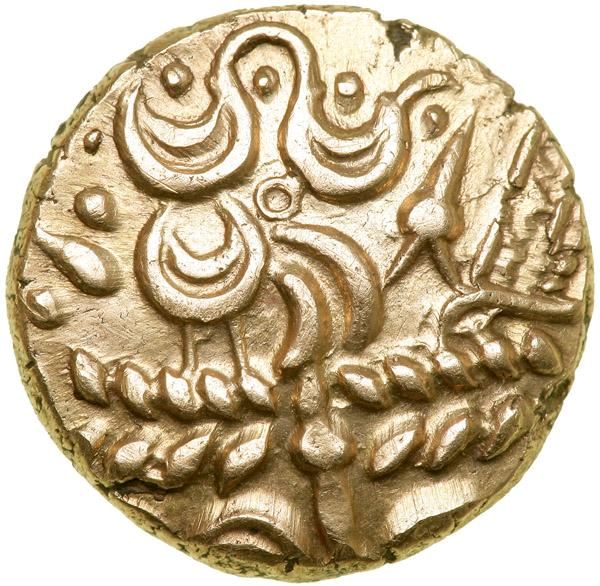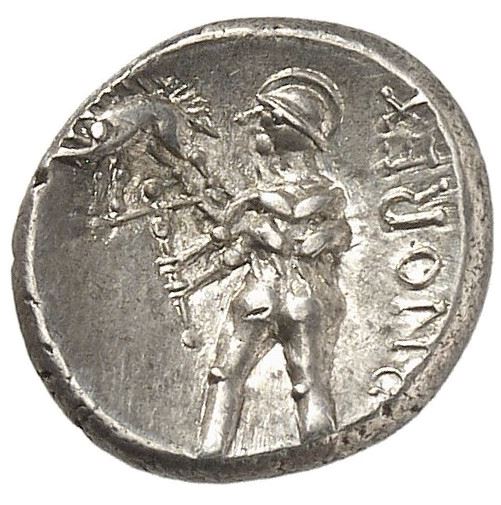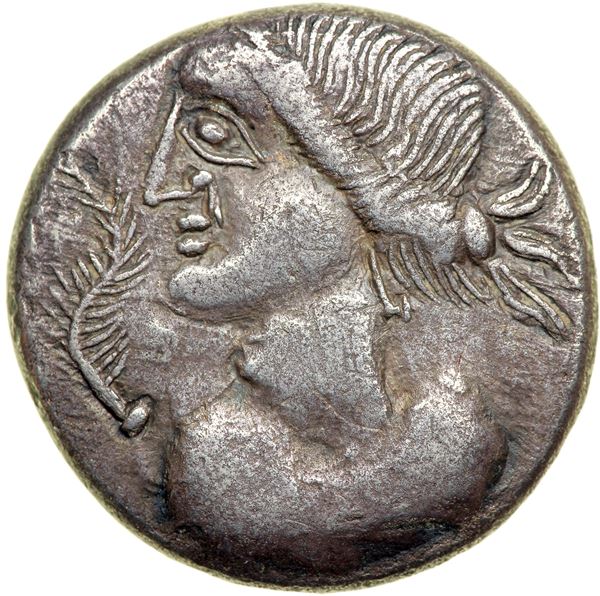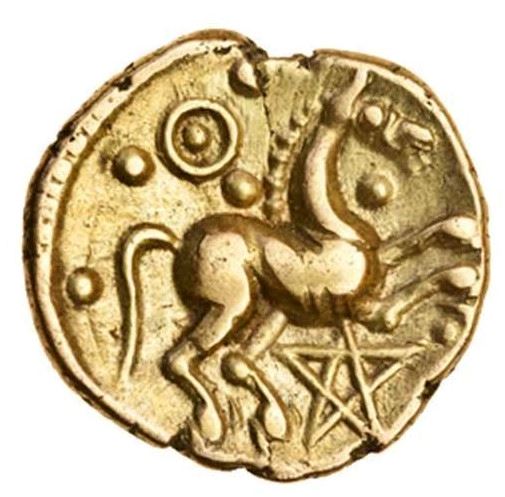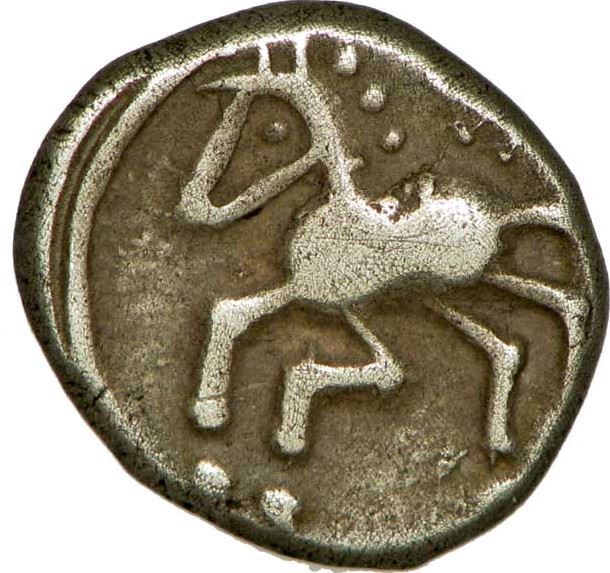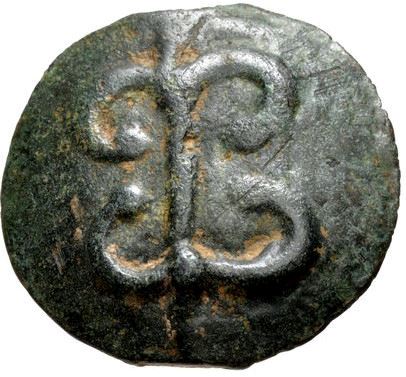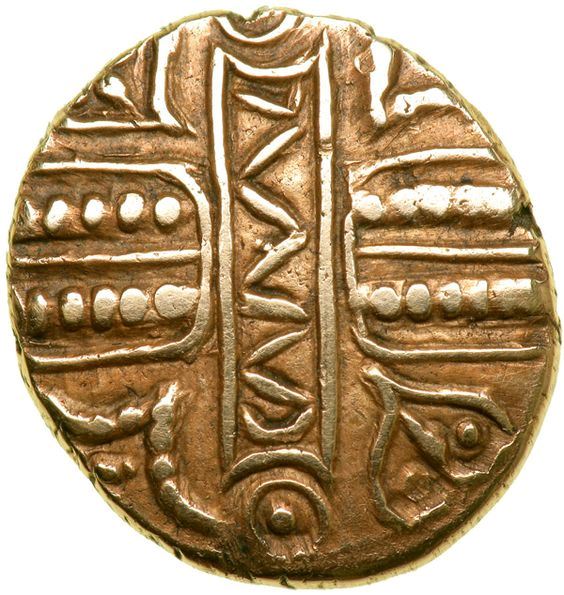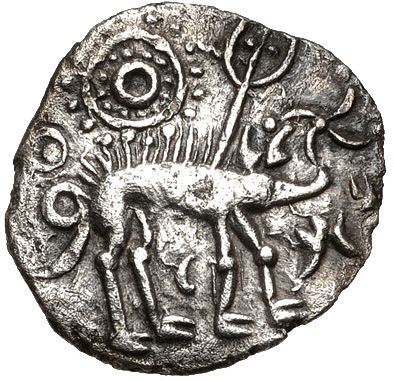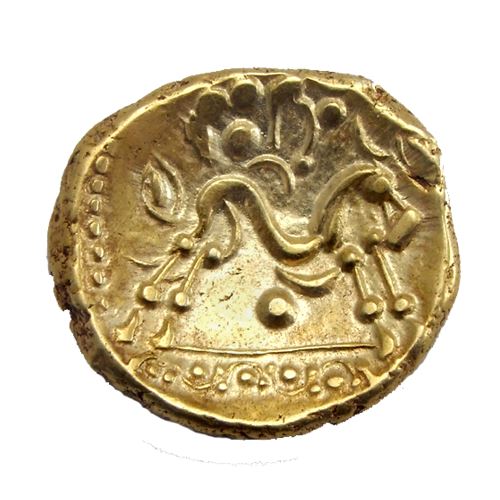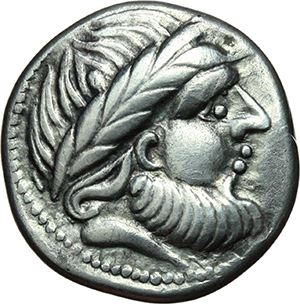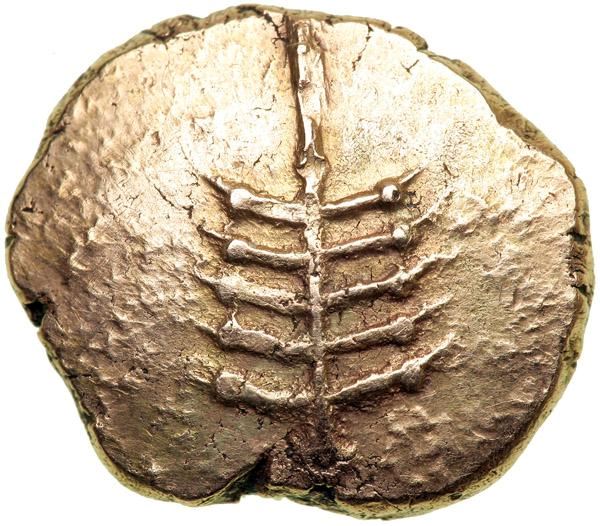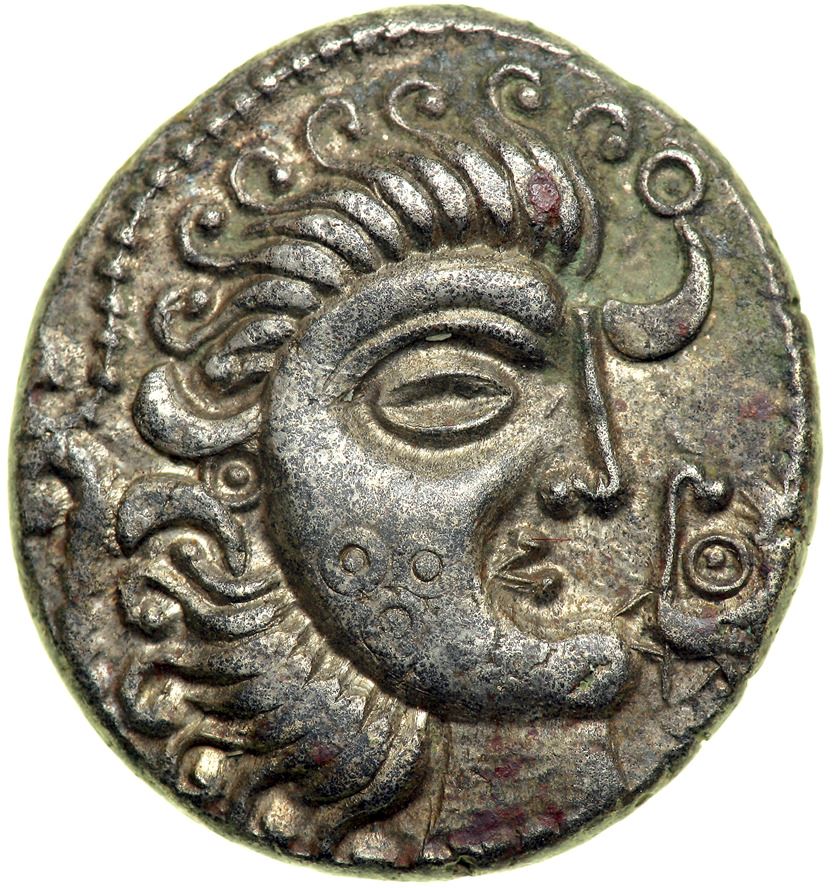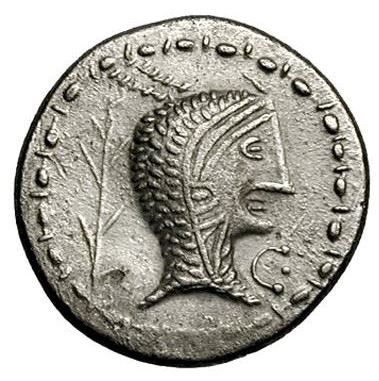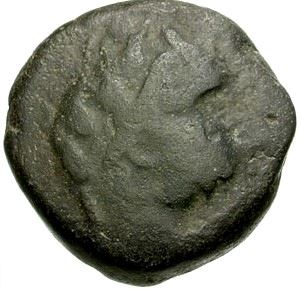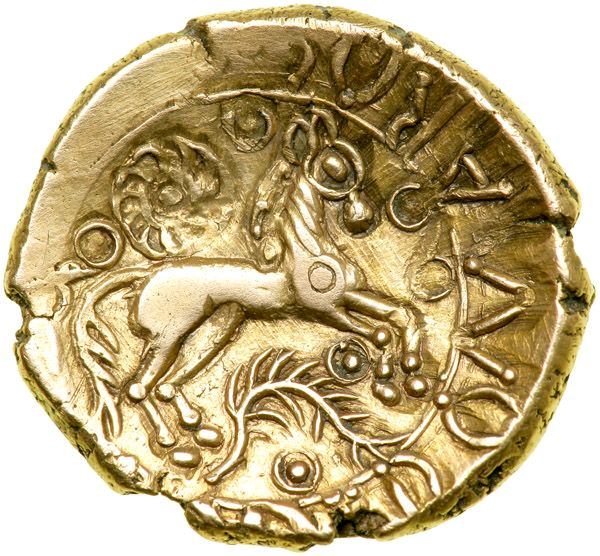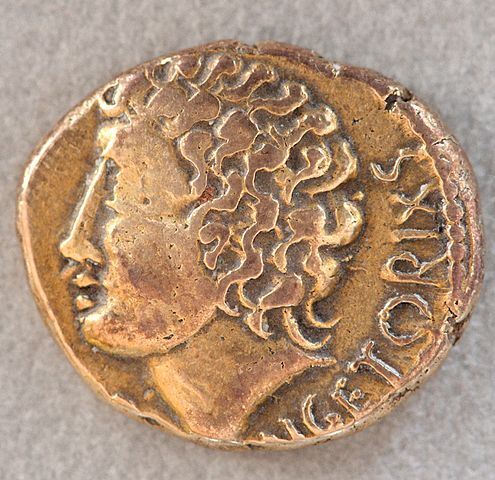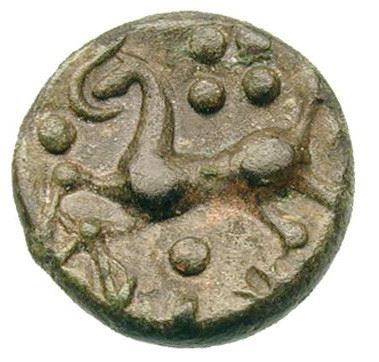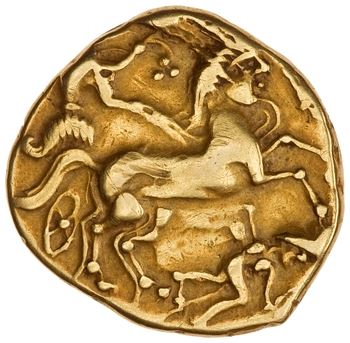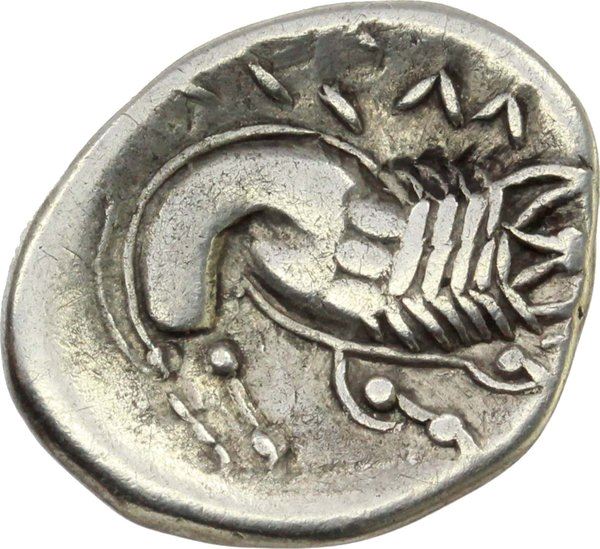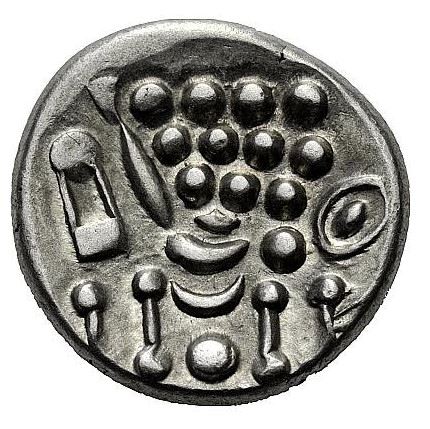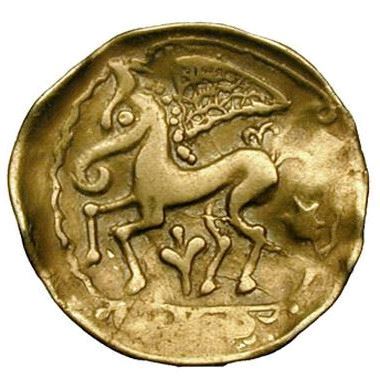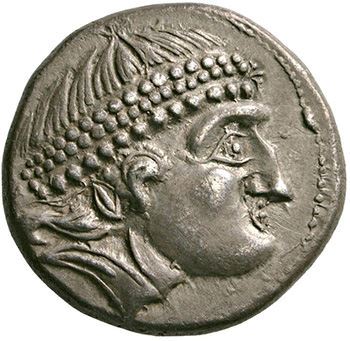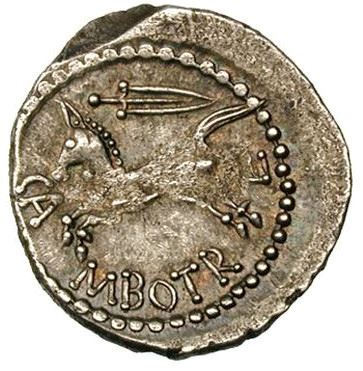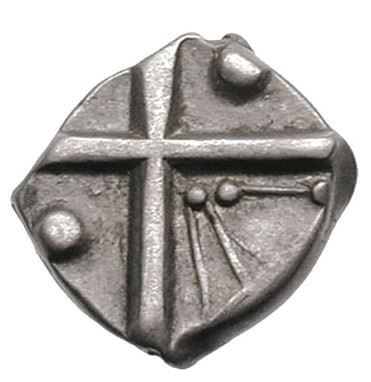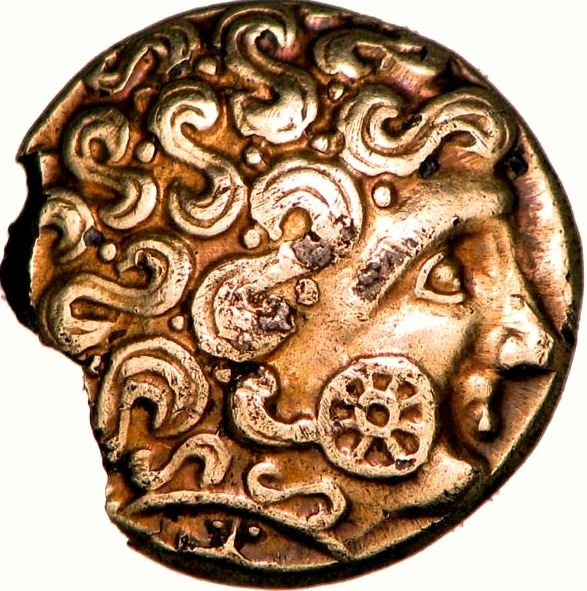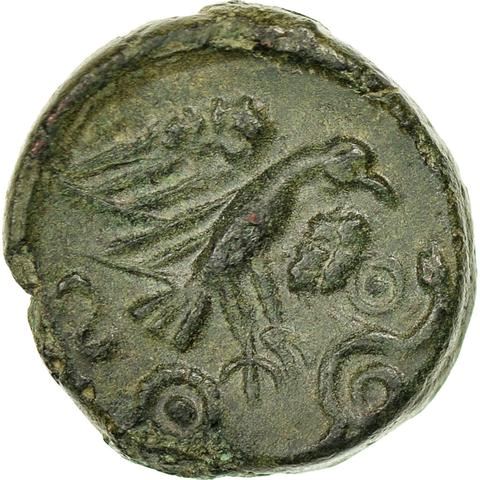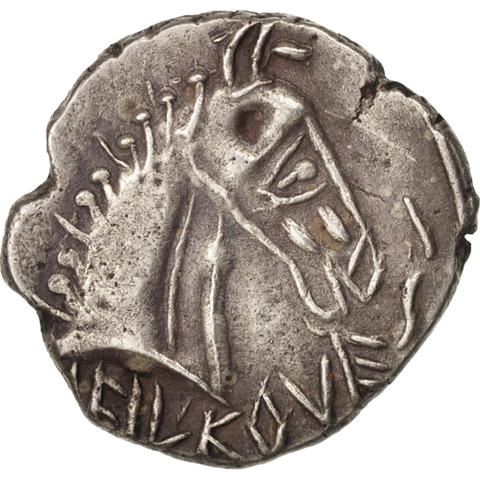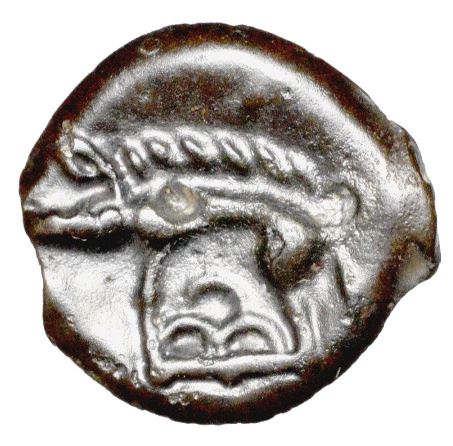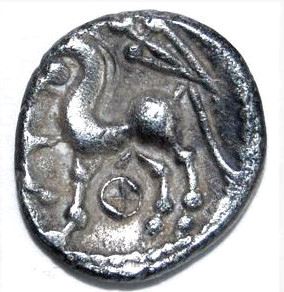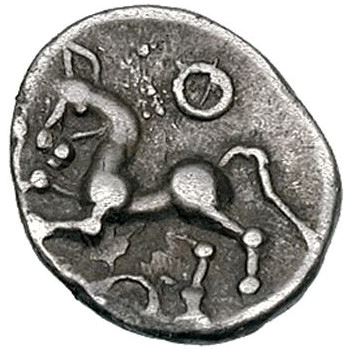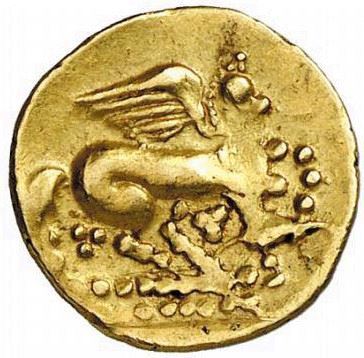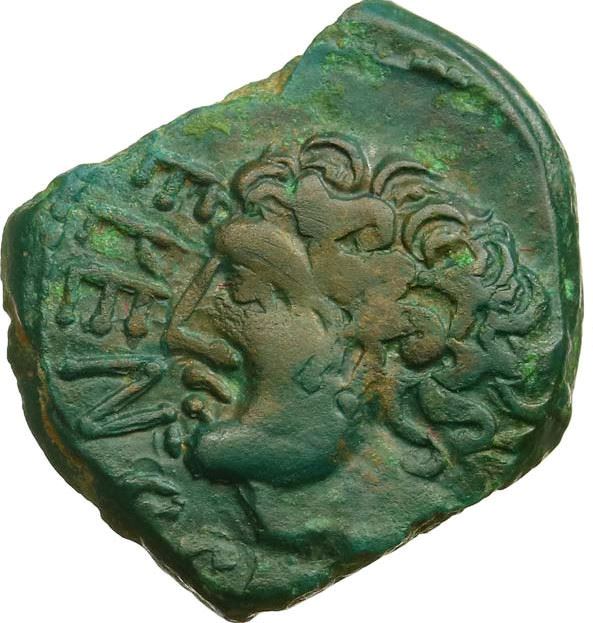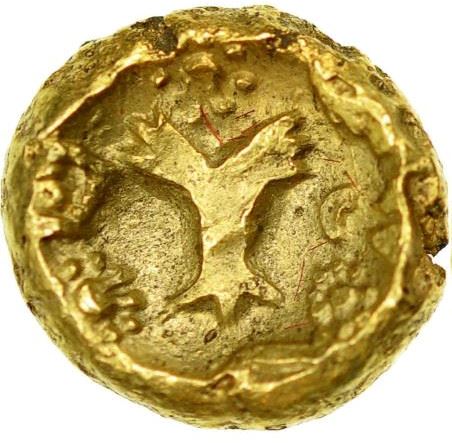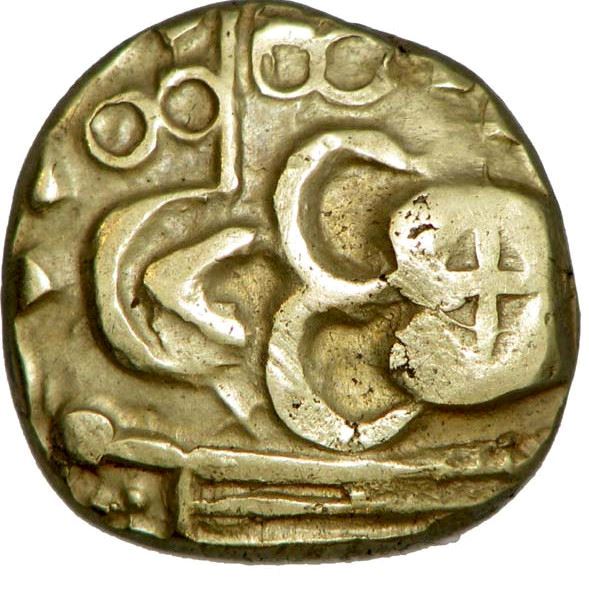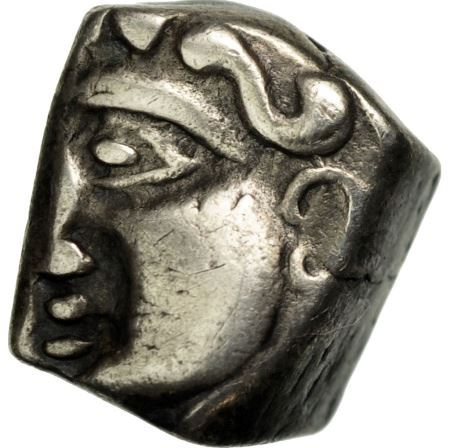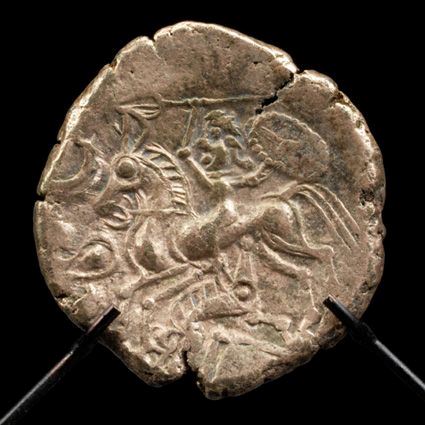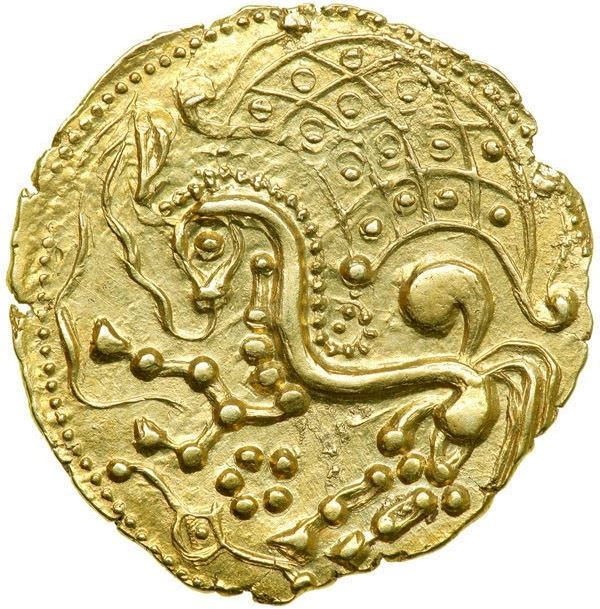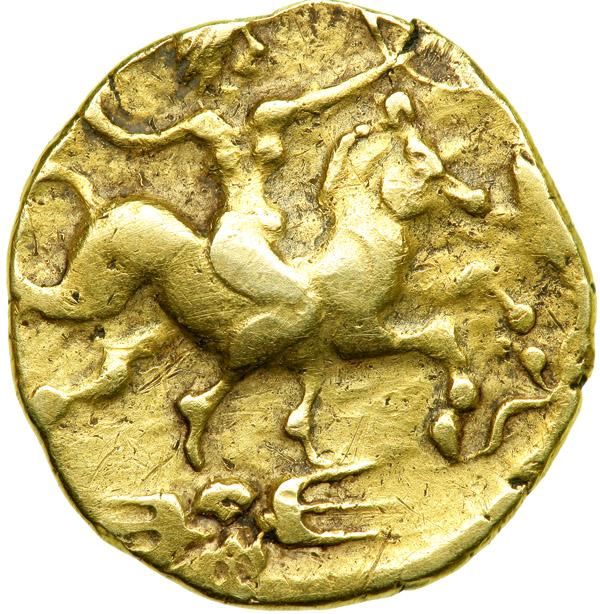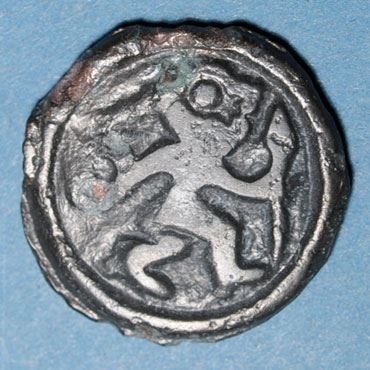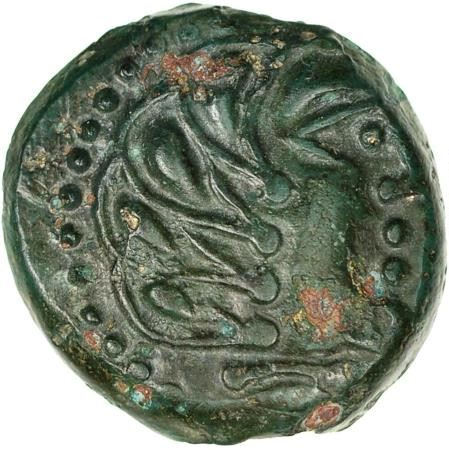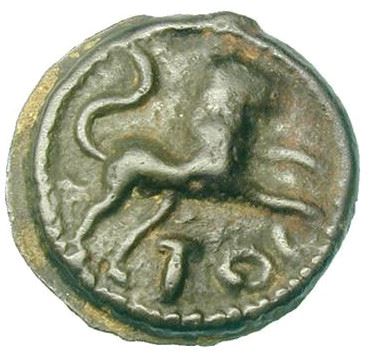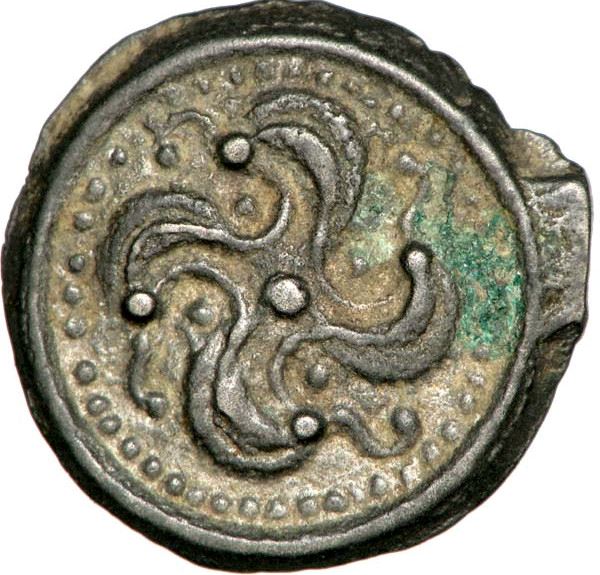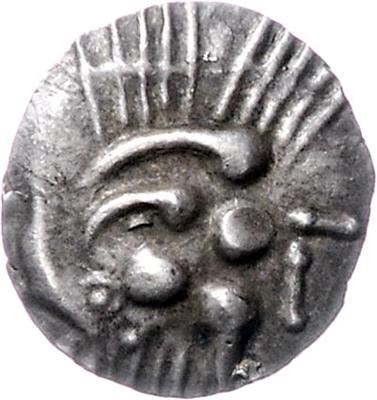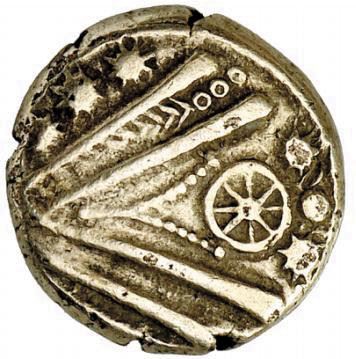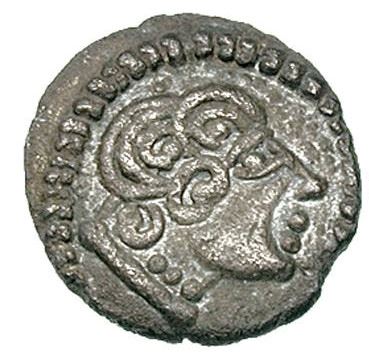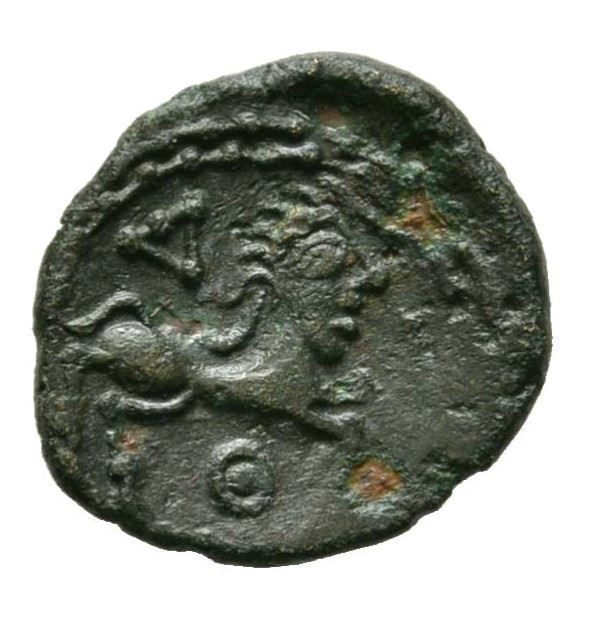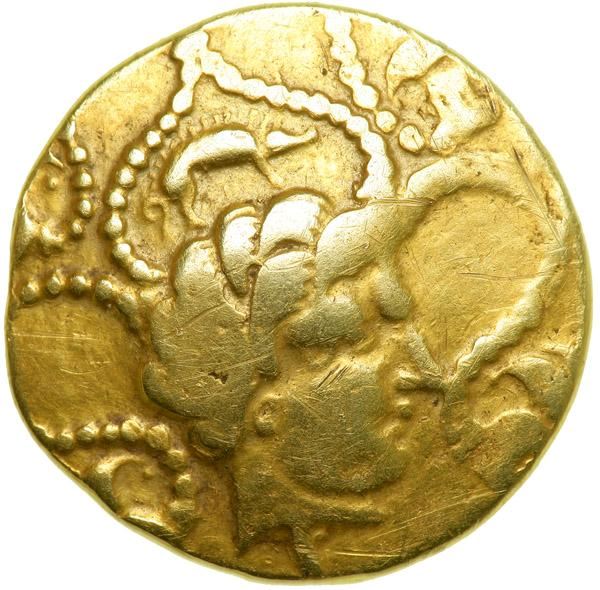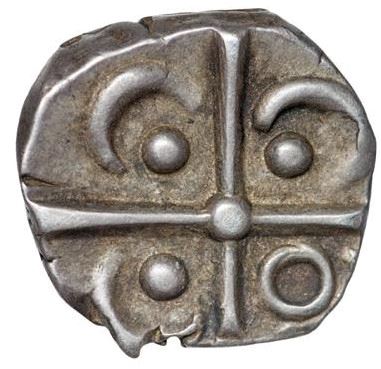Celtic coinage was minted by the Celts from the late 4th century BC to the late 1st century BC.
Celtic coin designs were influenced by trade with and the supply of mercenaries to the Greeks, and initially copied Greek designs, especially Macedonian coins from the time of Philip II of Macedon and his son, Alexander the Great.
In addition to gold and silver coins, the Celts on the continent and in southern Britain also produced potin coins using various combinations of copper and tin. These were small in size and were cast, not struck or hammered as were the dearer gold and silver coins.
Celtic coin designs were influenced by trade with and the supply of mercenaries to the Greeks, and initially copied Greek designs, especially Macedonian coins from the time of Philip II of Macedon and his son, Alexander the Great.
In addition to gold and silver coins, the Celts on the continent and in southern Britain also produced potin coins using various combinations of copper and tin. These were small in size and were cast, not struck or hammered as were the dearer gold and silver coins.
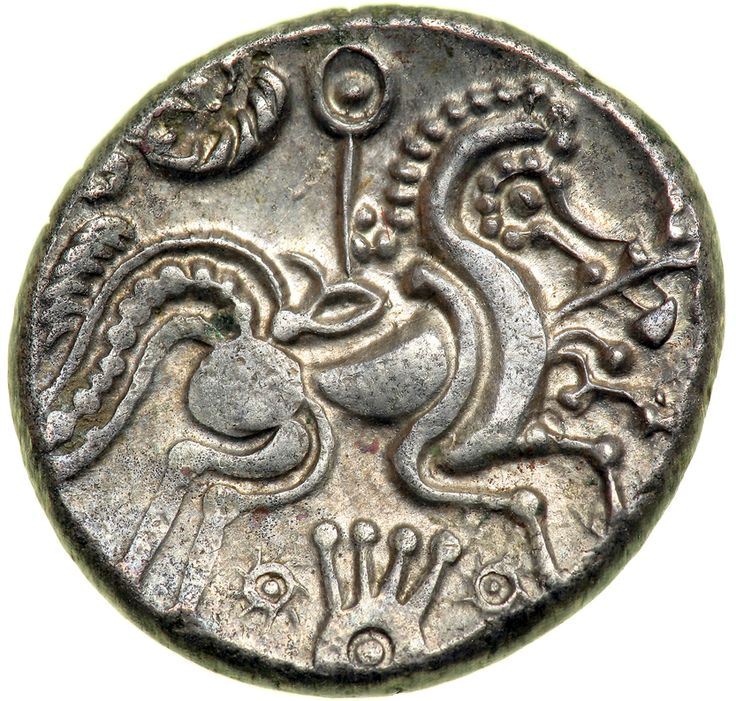
The Atrebates were a Belgic tribe of Gaul and Britain before the Roman conquests. In Britain, their territory comprised modern Hampshire, West Sussex and Berkshire.
After being defeated by Caesar in the Gallic Wars, he appointed a local noble King and the Atrebates were from then on recognized as a client kingdom of Rome.
Coins struck by the Atrebates in both Britain and Gaul...
After being defeated by Caesar in the Gallic Wars, he appointed a local noble King and the Atrebates were from then on recognized as a client kingdom of Rome.
Coins struck by the Atrebates in both Britain and Gaul...
The Aedui were a Gallic people of Gallia Lugdunensis, who inhabited the country between the Arar (Saône) and Liger (Loire), in today's France.
The Aedui, like other powerful tribes in the region had replaced their monarchy with a council of magistrates called grand-judges. The grand-judges were under the authority of the senate. The senate was made up of the descendants of ancient royal...
The Aedui, like other powerful tribes in the region had replaced their monarchy with a council of magistrates called grand-judges. The grand-judges were under the authority of the senate. The senate was made up of the descendants of ancient royal...
The Boii were a Gallic tribe of the later Iron Age, which was attested at various times in Italy, Pannonia, Bavaria, Bohemia, and Gallia Narbonensis.
They first appear in history in connection with the Gallic invasion of north Italy, 390 BC, when they made the Etruscan city of Felsina their new capital, Bononia (Bologna). After a series of wars they were decisively beaten by the Romans...
They first appear in history in connection with the Gallic invasion of north Italy, 390 BC, when they made the Etruscan city of Felsina their new capital, Bononia (Bologna). After a series of wars they were decisively beaten by the Romans...
The Cantii or Cantiaci were an Iron Age Celtic people living in Britain before the Roman conquest. They lived in the area now called Kent, in south-eastern England, and their capital was Durovernum Cantiacorum, now Canterbury.
Julius Caesar landed in Cantium in 55 and 54 BC, the first Roman expeditions to Britain - he writes that "Of all these (British tribes), by far the most civilise...
Julius Caesar landed in Cantium in 55 and 54 BC, the first Roman expeditions to Britain - he writes that "Of all these (British tribes), by far the most civilise...
The Allobroges were a Gallic tribe of ancient Gaul, located between the Rhône River and Lake Geneva in what later became Savoy, Dauphiné, and Vivarais. Their cities were in the areas of modern-day Annecy, Chambéry and Grenoble. Their capital was modern Vienne.
The first recorded reference to the Allobroges is from the Greek historian Polybius in 150-130 BC. He tells how they unsuccessfu...
The first recorded reference to the Allobroges is from the Greek historian Polybius in 150-130 BC. He tells how they unsuccessfu...
The Helvetii were a Gallic tribe or tribal confederation occupying most of the Swiss plateau at the time of their contact with the Roman Republic in the 1st century BC.
In 58 BC, they attempted to migrate to southern Gaul - an event serving as a catalyst for Caesar's conquest of Gaul. According to Caesar, the territory abandoned by the Helvetii had comprised 400 villages and 12 oppida ...
In 58 BC, they attempted to migrate to southern Gaul - an event serving as a catalyst for Caesar's conquest of Gaul. According to Caesar, the territory abandoned by the Helvetii had comprised 400 villages and 12 oppida ...
The Vindelici were a Celtic people in antiquity consisting of several tribes. Their territory was known to the Romans as Vindelicia. Together with the neighbouring tribes, the Vindelici were subjugated by Tiberius in 15 BC.
Little of the language of the Vindelici has survived, although place names suggest that they most probably spoke a variety of Gaulish, like the neighbouring Boii and...
Little of the language of the Vindelici has survived, although place names suggest that they most probably spoke a variety of Gaulish, like the neighbouring Boii and...
The Iceni or Eceni were a Brittonic tribe of eastern Britain during the Iron Age and early Roman era. Their territory included present-day Norfolk and parts of Suffolk and Cambridgeshire.
The Iceni were a significant power in eastern Britain during Claudius' conquest of Britain in AD 43, in which they allied with Rome. They remained nominally independent under king Prasutagus until his ...
The Iceni were a significant power in eastern Britain during Claudius' conquest of Britain in AD 43, in which they allied with Rome. They remained nominally independent under king Prasutagus until his ...
The Ambiani were a Belgic people of Celtic language, who were said to be able to muster 10,000 armed men, in 57 BC, the year of Julius Caesar's Belgic campaign.
Their country lay in the valley of the Samara (modern Somme); and their chief town Samarobriva, afterwards called Ambiani, is modern Amiens. They were among the people who took part in the great insurrection against the Romans, ...
Their country lay in the valley of the Samara (modern Somme); and their chief town Samarobriva, afterwards called Ambiani, is modern Amiens. They were among the people who took part in the great insurrection against the Romans, ...
The Scordisci were a Celtic Iron Age tribe centered in the territory of present-day Serbia, at the confluence of the Savus, Dravus and Danube rivers. They were historically notable from the beginning of the third century BC until the turn of the common era.
They consolidated into a tribal state. At their zenith, their core territory stretched over regions comprising parts of present-day...
They consolidated into a tribal state. At their zenith, their core territory stretched over regions comprising parts of present-day...
The Dobunni were one of the Iron Age tribes living in the British Isles prior to the Roman invasion of Britain. There are seven known references to the tribe in Roman histories and inscriptions.
The tribe lived in the part of southwestern Britain that today broadly coincides with the English counties of Bristol, Gloucestershire and the north of Somerset, although at times their territor...
The tribe lived in the part of southwestern Britain that today broadly coincides with the English counties of Bristol, Gloucestershire and the north of Somerset, although at times their territor...
The Armoricani were a tribe living in the area now called Brittany and all along the coast up to Dieppe in Normandy. They inhabited the area in the Iron Age, though there is plenty of evidence of earlier settlement in that part of Gaul.
Strabo and Poseidonius describe the Armoricani as belonging to the Gaulish Belgae and according to Tacitus were ousted by the Germani cisrhenani.
...
Strabo and Poseidonius describe the Armoricani as belonging to the Gaulish Belgae and according to Tacitus were ousted by the Germani cisrhenani.
...
The Eravasci were a Celtic people who inhabited Transdanubia. Most of what we know about them comes from archaeology and Roman literature.
They moved in from the north in about the third or fourth centuries BC. The Eravasci worked with iron, created jewelry and pottery, and minted their own coins out of silver. Most Celtic societies at this time were barter economies, therefore making t...
They moved in from the north in about the third or fourth centuries BC. The Eravasci worked with iron, created jewelry and pottery, and minted their own coins out of silver. Most Celtic societies at this time were barter economies, therefore making t...
The Serdi were a Celtic tribe inhabiting Thrace. They were located around Serdika, now Sofia in Bulgaria, which reflects their ethnonym.
They would have established themselves in this area during the Celtic migrations at the end of the 4th century BC, though there is no evidence for their existence before the 1st century BC. Serdi are among traditional tribal names reported into the Rom...
They would have established themselves in this area during the Celtic migrations at the end of the 4th century BC, though there is no evidence for their existence before the 1st century BC. Serdi are among traditional tribal names reported into the Rom...
The Catuvellauni were a Celtic tribe or state of southeastern Britain before the Roman conquest, attested by inscriptions into the 4th century.
Tasciovanus was the first king to mint coins at Verlamion, beginning ca 20 BC. He appears to have expanded his power at the expense of the Trinovantes to the east, as some of his coins, ca 15–10 BC, were minted in their capital Camulodunum (mode...
Tasciovanus was the first king to mint coins at Verlamion, beginning ca 20 BC. He appears to have expanded his power at the expense of the Trinovantes to the east, as some of his coins, ca 15–10 BC, were minted in their capital Camulodunum (mode...
The Arverni were a Celtic tribe, which was located in what is today the French Auvergne region, which derives its name from the Arverni.
As one of the most powerful tribes in ancient Gaul, the Arverni opposed the Romans on several occasions. One of their most important stronghold was Gergovia, near the present-day commune of Clermont-Ferrand.
In the aftermath of the Gallic Wa...
As one of the most powerful tribes in ancient Gaul, the Arverni opposed the Romans on several occasions. One of their most important stronghold was Gergovia, near the present-day commune of Clermont-Ferrand.
In the aftermath of the Gallic Wa...
The Cotini were a Gaulish tribe living during Roman times in the mountains approximately near the modern borders of the Czech Republic, Poland (Silesia), and Slovakia.
Tacitus described the Cotini as speaking a Gaulish language and working, to their degradation, in mining. Like their neighbours in the mountains, the Osi, they had to pay tribute to both the neighbouring Quadi and Sarmati...
Tacitus described the Cotini as speaking a Gaulish language and working, to their degradation, in mining. Like their neighbours in the mountains, the Osi, they had to pay tribute to both the neighbouring Quadi and Sarmati...
Aulerci is a generic name for some of the Celtic peoples of ancient Gaul, which included several Celtic tribes.
They joined Bellovesus' migrations towards Italy, together with the Aeduii, Ambarri, Arverni, Carnutes and Senones.
They joined Bellovesus' migrations towards Italy, together with the Aeduii, Ambarri, Arverni, Carnutes and Senones.
The Insubres or Insubri were a Gaulish population settled in Insubria, in what is now the Italian region of Lombardy. They were the founders of Mediolanum (Milan).
Though completely Gaulish at the time of Roman conquest, they were the result of the fusion of pre-existing Ligurian and Celtic population with Gaulish tribes.
After several other clashes, the Insubres made an all...
Though completely Gaulish at the time of Roman conquest, they were the result of the fusion of pre-existing Ligurian and Celtic population with Gaulish tribes.
After several other clashes, the Insubres made an all...
The Durotriges were one of the Celtic tribes living in Britain prior to the Roman invasion. The tribe lived in modern Dorset, south Wiltshire, south Somerset and Devon east of the River Axe and the discovery of an Iron Age hoard in 2009 at Shalfleet, Isle of Wight gives evidence that they lived in the western half of the island.
The Durotriges were more a tribal confederation than a tri...
The Durotriges were more a tribal confederation than a tri...
The Bellovaci were among the most powerful and numerous of the Belgian tribes of north-eastern Gaul conquered by Julius Caesar in 57 BC. The name survives today in the French city of Beauvais, called by the Romans Caesaromagus.
The Bellovaci fought Caesar during the Gallic Wars. Bellovaci employed guerrilla warfare, in particular targeting Roman foragers. Meanwhile, Caesar's strategic p...
The Bellovaci fought Caesar during the Gallic Wars. Bellovaci employed guerrilla warfare, in particular targeting Roman foragers. Meanwhile, Caesar's strategic p...
Noricum is the Latin name for a Celtic kingdom, or federation of tribes, that included most of modern Austria and part of Slovenia.
Noricum was a major provider of weaponry for the Roman armies from the mid-Republic onwards. Roman swords were made of the best-quality steel then available from this region, the chalybs Noricus. The strength of iron is determined by its carbon content. Th...
Noricum was a major provider of weaponry for the Roman armies from the mid-Republic onwards. Roman swords were made of the best-quality steel then available from this region, the chalybs Noricus. The strength of iron is determined by its carbon content. Th...
The Bituriges were a tribe of Celtic Gaul with its capital at Bourges (Avaricum). Their name supposedly meant "kings of the world".
Early in the 1st century BC, they had been one of the main Gallic tribes, especially in terms of druids and their political influence. But they soon declined in power as the druids were an important target for Julius Caesar in his conquest of Gaul.
Early in the 1st century BC, they had been one of the main Gallic tribes, especially in terms of druids and their political influence. But they soon declined in power as the druids were an important target for Julius Caesar in his conquest of Gaul.
The Cadurci were a Celtic people of Gaul before the Roman conquest in the 50s BC. The Cadurci were among the last Celtic tribes to resist the Roman invasion.
Their capital was called Cardurcorum by the Romans - modern Cahors. After the Gallic Wars,, romanization was rapid and profound : Cahors became a large Roman city, with many monuments whose remnants can be seen today.
T...
Their capital was called Cardurcorum by the Romans - modern Cahors. After the Gallic Wars,, romanization was rapid and profound : Cahors became a large Roman city, with many monuments whose remnants can be seen today.
T...
The Carnutes, a powerful Gaulish people in the heart of independent Gaul, dwelt in an extensive territory between the Sequana (Seine) and the Liger (Loire) rivers.
The territory of the Carnutes had the reputation among Roman observers of being the political and religious center of the Gaulish nations. The great annual druidic assembly mentioned by Caesar took place in one or the other o...
The territory of the Carnutes had the reputation among Roman observers of being the political and religious center of the Gaulish nations. The great annual druidic assembly mentioned by Caesar took place in one or the other o...
The Cavares were a Gallic tribe, or a federation of tribes, located in the lower Rhone valley. Their strongholds were Avignon (Avennio), Orange (Arausio) and Cavaillon (Cabellio).
Cauares is believed to be a Gaulish ethnic name meaning "Heroes, Champions"; it is likely related to Old Irish caur "hero, champion warrior" and Welsh cawr, "giant, hero".
Cauares is believed to be a Gaulish ethnic name meaning "Heroes, Champions"; it is likely related to Old Irish caur "hero, champion warrior" and Welsh cawr, "giant, hero".
The Leuci were a Gallic tribe, recorded to have lived in the southern part of what is now Lorraine. They are mentioned by Julius Caesar as a people supplying wheat to the Roman army in 58 BC, along with the Lingones and Sequani.
Hillforts in the region of the Leuci include some small ones in the Vosges, and Boviolles in the Ornain valley in the west of the territory. There is also a pos...
Hillforts in the region of the Leuci include some small ones in the Vosges, and Boviolles in the Ornain valley in the west of the territory. There is also a pos...
The Lemovici were a Gaulish tribe of Central Europe who established themselves in Limousin and Poitou between 700 and 400 BC. Their capital was Durotincum (Villejoubert) and in the era of Roman occupation, it was Augustoritum (Limoges).
Lémovices stems from lemo « elm » and vices « who win » (« winners with elm »), their lances probably made out of elm.
In 52 BC, some 10,000 ...
Lémovices stems from lemo « elm » and vices « who win » (« winners with elm »), their lances probably made out of elm.
In 52 BC, some 10,000 ...
The Lingones were a Celtic tribe that originally lived in Gaul in the area of the headwaters of the Seine and Marne rivers.
Some of the Lingones migrated across the Alps and settled near the mouth of the Po River in Cisalpine Gaul of northern Italy around 400 BC. These Lingones were part of a wave of Celtic tribes that included the Boii and Senones. The Lingones may have helped sack Ro...
Some of the Lingones migrated across the Alps and settled near the mouth of the Po River in Cisalpine Gaul of northern Italy around 400 BC. These Lingones were part of a wave of Celtic tribes that included the Boii and Senones. The Lingones may have helped sack Ro...
The Mediomatrici were an ancient Celtic people of Gaul, who belong to the division of Belgae. Julius Caesar shows their position in a general way when he says that the Rhine flows along the territories of the Sequani, Mediomatrici, Triboci or Tribocci, and Treviri.
The name "Mediomatrici" has been explained as "the people between the Matrona (Marne) and the Matra."
It appears...
The name "Mediomatrici" has been explained as "the people between the Matrona (Marne) and the Matra."
It appears...
The Meldi were a Celtic tribe inhabiting the area around modern Meaux. The name seems to have meant the 'Honey people'.
The meldi struck bronze coins.
The meldi struck bronze coins.
The Morini (from the Gaulish morinos "seaman") were a Belgic tribe of northern Gaul. They became an established part of the Roman empire with the coastal parts of the present-day départment of Pas-de-Calais in northernmost France, bordering on the English Channel. A generation after their entry into the Roman Empire the writer Vergil described them poetically as the remotest of people.
...
...
The Nervii were one of the most powerful Celtic tribes living in northern Gaul at the time of its conquest by Rome.
Their territory corresponds to the central part of modern Belgium, including Brussels, and stretched southwards into French Hainault. During their 1st century BC Roman military campaign, Caesar's contacts among the Remi stated that the Nervii were the most warlike of the B...
Their territory corresponds to the central part of modern Belgium, including Brussels, and stretched southwards into French Hainault. During their 1st century BC Roman military campaign, Caesar's contacts among the Remi stated that the Nervii were the most warlike of the B...
The Nitiobroges were a Gallic tribe. By the middle of the first century BC, the they were located along the northern bank of the Garunna (the modern Garonne) in southern-central Gaul.
In common with other Celts in the south-west of France, the Nitiobroges seem to have arrived relatively late, perhaps around the start of the third century BC. They edged out the native Aquitanians in part...
In common with other Celts in the south-west of France, the Nitiobroges seem to have arrived relatively late, perhaps around the start of the third century BC. They edged out the native Aquitanians in part...
The Osismii were a Gaulish tribe on the western Armorican peninsula. They were first described as the Ostimioi by the Greek geographer and traveller Pytheas in the fourth century BC.
Their name (Ostimioi) means "the farthest" or "those at the end of the world". Their territory corresponded broadly to the modern French département of Finistère, whose name reflects the same meaning in Lat...
Their name (Ostimioi) means "the farthest" or "those at the end of the world". Their territory corresponded broadly to the modern French département of Finistère, whose name reflects the same meaning in Lat...
The Parisii were Celtic Iron Age people who lived on the banks of the river Seine (in Latin, Sequana) in Gaul from the middle of the third century BC until the Roman era. With the Suessiones, the Parisii participated in the general rising of Vercingetorix against Julius Caesar in 52 BC.
The tribe's chief city (or oppidum), which the Parisii colonized in about 250 BC, was later the site ...
The tribe's chief city (or oppidum), which the Parisii colonized in about 250 BC, was later the site ...
The Redoned were an ancient tribe of Gaul. Their capital was Condate (modern Rennes).
After the bloody fight on the Sambre (57 BCE) Julius Caesar sent Publius Licinius Crassus with a single legion into the country of the Veneti, Riedones, and other Celtic tribes between the Seine River and the Loire, all of whom submitted.
Caesar enumerates the Riedones among the maritime sta...
After the bloody fight on the Sambre (57 BCE) Julius Caesar sent Publius Licinius Crassus with a single legion into the country of the Veneti, Riedones, and other Celtic tribes between the Seine River and the Loire, all of whom submitted.
Caesar enumerates the Riedones among the maritime sta...
The Remi were a Belgic people of north-eastern Gaul (Gallia Belgica). The Remi were known to be a rather overweight tribe because of their vast supply of food available on the Champagne Plain. In fact, being obese was an honor in the Remi tribe.
During the Gallic Wars in the mid-1st century BC, they allied themselves under the leadership of Iccius and Andecombogius with Julius Caesar. T...
During the Gallic Wars in the mid-1st century BC, they allied themselves under the leadership of Iccius and Andecombogius with Julius Caesar. T...
The Senones were an ancient Celtic Gallic culture, which joined Bellovesus' migrations towards Italy, together with the Aeduii, Ambarri, Arverni, Aulerci, and the Carnutes.
Here, they drove out the Umbrians settled on the east coast of Italy and founded the town of Sena Gallica (Senigallia), which became their capital.
In 391 BCE, under the chieftain Brennus, they invaded E...
Here, they drove out the Umbrians settled on the east coast of Italy and founded the town of Sena Gallica (Senigallia), which became their capital.
In 391 BCE, under the chieftain Brennus, they invaded E...
The Sequani were a Gallic people who occupied the upper river basin of the Arar (Saône), the valley of the Doubs and the Jura Mountains, their territory corresponding to Franche-Comté and part of Burgundy.
Before the arrival of Julius Caesar in Gaul, the Sequani had taken the side of the Arverni against their rivals the Aedui and hired the Suebi under Ariovistus to cross the Rhine and h...
Before the arrival of Julius Caesar in Gaul, the Sequani had taken the side of the Arverni against their rivals the Aedui and hired the Suebi under Ariovistus to cross the Rhine and h...
The Suessiones were a Belgic tribe of western Gallia Belgica in the 1st century BC, inhabiting the region between the Oise and the Marne, around the present-day city of Soissons.
Caesar describes the Belgae as going to Britain looking for booty: "The inland part of Britain is inhabited by tribes declared in their own tradition to be indigenous to the island, the maritime part by tribes ...
Caesar describes the Belgae as going to Britain looking for booty: "The inland part of Britain is inhabited by tribes declared in their own tradition to be indigenous to the island, the maritime part by tribes ...
The Sotiates were a pre-Roman tribe of the Aquitani, settled in what today is southwestern France. Their capital was the city of Sotium, present-day Sos.
They struck silver coins with highly stylized imagery.
They struck silver coins with highly stylized imagery.
The Treveri or Treviri were a Belgic tribe who inhabited the lower valley of the Moselle from around 150 BC.
Although early adopters of Roman material culture, the Treveri had a chequered relationship with Roman power. Their leader Indutiomarus led them in revolt against Julius Caesar during the Gallic Wars; much later, they played a key role in the Gaulish revolt during the Year of the...
Although early adopters of Roman material culture, the Treveri had a chequered relationship with Roman power. Their leader Indutiomarus led them in revolt against Julius Caesar during the Gallic Wars; much later, they played a key role in the Gaulish revolt during the Year of the...
The Vangiones appear first in history as an ancient Germanic tribe of unknown provenance. They threw in their lot with Ariovistus in his bid of 58 BC to invade Gaul through the Doubs river valley and lost to Julius Caesar in a battle probably near Belfort.
After some Celts evacuated the region in fear of the Suebi, the Vangiones, who had made a Roman peace, were allowed to settle among ...
After some Celts evacuated the region in fear of the Suebi, the Vangiones, who had made a Roman peace, were allowed to settle among ...
n pre-Roman Gaul the Belgic tribe of the Veliocasses or Velocasses controlled a large area in the lower Seine valley, which retains a trace of their name, as the Vexin.
According to Julius Caesar' Commentary on the Gallic Wars the Veliocasses participated in the tribal coalition of the Belgae that resisted the Romans in 57 BCE. In 52 they raised 3000 men to support Vercingetorix, and fo...
According to Julius Caesar' Commentary on the Gallic Wars the Veliocasses participated in the tribal coalition of the Belgae that resisted the Romans in 57 BCE. In 52 they raised 3000 men to support Vercingetorix, and fo...
The Veneti were a seafaring Celtic people who lived in the Brittany peninsula (France), which in Roman times formed part of an area called Armorica. They gave their name to the modern city of Vannes.
The Veneti built their ships of oak with large transoms fixed by iron nails of a thumb's thickness. They navigated and powered their ships through the use of leather sails. This made their ...
The Veneti built their ships of oak with large transoms fixed by iron nails of a thumb's thickness. They navigated and powered their ships through the use of leather sails. This made their ...
The Volcae were a tribal confederation constituted before the raid of combined Gauls that invaded Macedonia c. 270 BC and fought the assembled Greeks at the Battle of Thermopylae in 279 BC.
Tribes known by the name Volcae were found simultaneously in southern Gaul, Moravia, the Ebro valley of the Iberian Peninsula, and Galatia in Anatolia.
The Volcae Tectosages in Gaul struc...
Tribes known by the name Volcae were found simultaneously in southern Gaul, Moravia, the Ebro valley of the Iberian Peninsula, and Galatia in Anatolia.
The Volcae Tectosages in Gaul struc...

